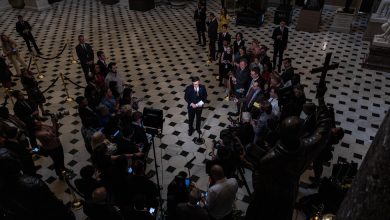There’s No Real Ceiling for Federal Debt? I’m Not So Sure.

I’ve written and spoken respectfully about believers in modern monetary theory over the years, so some M.M.T.-ers were taken aback when I seemed to dismiss their ideas in my newsletter last week. I wrote, “Unless you subscribe to modern monetary theory, which holds that deficits don’t matter unless they cause inflation, something has to be done” about rising federal deficits.
One reader, Nick Estes of Albuquerque, wrote to me, “I’m afraid that M.M.T. is right about the national debt. If deficits cause inflation, reduce them. Otherwise, deficits are not a problem, regardless of the buildup of the national debt that results.”
Stephanie Kelton, an economist at Stony Brook University who is a leading advocate of M.M.T., cited my piece with dismay in her Substack newsletter and wrote, “Too many people are committed to repeating inapplicable household metaphors and chasing after headlines with tales of fiscal doom.” (Ouch.)
I think Kelton and other M.M.T.-ers are correct that the fear of deficits can lead policymakers to make dumb mistakes. As the economy heads toward a possible recession, this is not the time for big spending cuts or tax hikes. The government will need to spend more to offset private cutbacks. Taking aggressive measures to balance the federal budget now, as many Republican lawmakers say they want to do, would crush spending by consumers and businesses and throw millions of people out of work. I’m with Paul Krugman, Dean Baker and many others on that.
On the other hand, I still can’t fully wrap my mind around M.M.T.’s assertion that “the national debt poses no financial burden whatsoever,” as Kelton wrote in her 2020 book, “The Deficit Myth: Modern Monetary Theory and the Birth of the People’s Economy.”
For today’s newsletter I interviewed Kelton as well as a prominent mainstream economist, Olivier Blanchard, a professor emeritus at the Massachusetts Institute of Technology who is a former chief economist of the International Monetary Fund. Sorting out their disagreements isn’t easy, because their worldviews and vocabulary don’t interact much. They’re like ships passing in the night.
Modern monetary theory says that since the United States issues its own currency, it can always produce more of it to pay the bills. (Like a banker in Monopoly who gets out the colored paper and makes more $50s and $100s.) According to M.M.T., the only risk of deficit spending is that too much of it will cause prices to go up because demand for goods and services will exceed the supply of them.
Kelton and her fellow modern monetary theorists also argue, contrary to conventional wisdom, that the federal government doesn’t need to sell bonds to raise money from investors when its spending exceeds tax revenue. So, no problem with the debt ceiling! It says the investors who write checks to buy government bonds are simply exchanging one form of money for another, replacing their cash with government securities. In M.M.T. lingo, there’s no meaningful difference between interest-earning bonds issued by the Treasury (“yellow dollars”) and interest-earning reserves issued by the Fed (“green dollars”). Running deficits without issuing bonds would just leave more of the green dollars in the financial system and less of the yellow kind, without any impact on inflation, they argue.
For M.M.T. to hang together, you have to believe that the ostensibly independent Federal Reserve does whatever the government needs it to do. The Fed and the Treasury Department “work hand in glove every single day,” Kelton told me. “The Fed is the government’s fiscal agent. There is no way that the Federal Reserve can stand separate and apart from the Treasury’s needs to clear payments.”
Most mainstream economists and participants in the financial markets argue that the Fed is and should remain independent of the Treasury — for example, in setting interest rates. They worried during “quantitative easing,” when the Fed was buying trillions of dollars in Treasuries on the open market to suppress long-term interest rates, because the central bank was effectively financing the federal government’s deficit spending. They worried that the government wasn’t subject to the discipline of investors, who demand higher interest rates when the government borrows heavily.
M.M.T.-ers point out that the Federal Reserve has the power to set interest rates wherever it wants, even all the way down to zero. True, but that could cause inflation by encouraging a lot of borrowing (because when the Fed lowers interest rates, the rates on car loans, mortgages and other forms of borrowing tend to fall as well). Kelton told me that there are new ideas for how to break the linkage, so zero rates on Treasuries wouldn’t cause excessively low rates on, say, mortgages. In any case, she argued, there’s little if any evidence that low rates set by the Fed cause inflation, pointing to the long period when the federal funds rate was near zero but inflation stayed stubbornly below the Fed’s 2 percent target. If anything, she wrote in an email, the causality is reversed: “Looks to me like rate hikes chase inflation up” and then rate cuts chase it back down.
While modern monetary theory says that a rising ratio of debt to gross domestic product doesn’t have to raise interest rates, in practice that’s what has usually happened. James Poterba, the Massachusetts Institute of Technology economist I quoted last week, wrote in a follow-up email: “One study of the 1976-2017 period by Ed Gamber and John Seliski of the Congressional Budget Office found that on average, when the debt-to-G.D.P. ratio rose by 10 percentage points, real interest rates on long-term Treasuries rose by about 20 basis points.” That’s 0.2 percentage points. “A number of other studies of the U.S. experience in the post-World War II period have produced broadly similar results,” he added.
Blanchard, the former chief economist of the International Monetary Fund, is fairly dovish on inflation and deficits. For example, he argues that central banks should set their inflation targets at 3 percent, not the current 2 percent. He told me he started working on the question of debt sustainability about five years ago to confront “fiscal hawks on both sides of the ocean” who contend that “debt is a catastrophe, and we have to reduce it and if we don’t the world comes to an end.” The book that resulted from his research, “Fiscal Policy Under Low Interest Rates,” was published on Jan. 10.
Blanchard pointed out in the book that if the interest rate the government pays on its debt is lower than the economy’s growth rate, the existing stock of debt will feel lighter over time because it will shrink as a share of gross domestic product even if the government isn’t running surpluses. In fact, he argued, the government can and should run deficits in that situation, as long as they aren’t too big. (Blanchard credits the notion to the economists Paul Samuelson, Edmund Phelps and Peter Diamond, among others. Scott Fullwiler, an M.M.T.-er at the University of Missouri-Kansas City, has been making the same point since 2006.)
But Blanchard didn’t give a carte blanche to deficit spending. The risk, he wrote, is that the felicitous coincidence of a low interest rate and a high growth rate could abruptly end. If the interest rate for some reason goes higher than the growth rate, and the government continues to run budget deficits, debt as a share of G.D.P. will “explode,” he wrote.
The fear of such an explosion can be a self-fulfilling prophecy. If investors start to fear that debt will become unsustainable, they will demand higher yields on the debt they own and will cause the very problem they fear, Blanchard wrote. It’s impossible to know when that reversal will occur, so it’s best to be cautious, he wrote.
“Debt is sustainable if the probability of a debt explosion is small,” he wrote. That’s an assertion that a lot of people could agree with. The big question: How small is that probability?
Outlook: Tuan Nguyen
Consumer spending adjusted for inflation fell 0.3 percent in December, the Bureau of Economic Analysis announced Friday. That’s fresh evidence of a slowdown in the U.S. economy, according to Tuan Nguyen, an economist at RSM US, which provides auditing, tax and consulting to midsize companies. “Inflation is falling fast, and the Fed has signaled that it will slow its rate hike campaign starting with a 25 basis-point hike,” Nguyen wrote in a blog post on Friday. He added: “We are comfortable with our base forecast of a mild recession later this year.”
Quote of the Day
“China’s national reality dictates that opening up to the world is a must, not an expediency. We must open up wider and make it work better.”
— Liu He, vice premier of China, at the World Economic Forum annual meeting in Davos, Switzerland (Jan. 17, 2023)
Have feedback? Send a note to [email protected].



